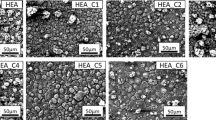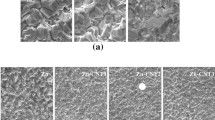Abstract
This research was conducted to explore the potential of incorporating carbon nanotubes (CNTs) into metallic tin (Sn) to enhance its corrosion-resistant property. Specific objective was to study the correlation between coating morphology, micro-texture, and corrosion behavior of Sn-CNT composite coatings. The study showed existence of an optimum CNT concentration that yields high corrosion resistance. The composite coatings were formed over steel substrate by electrodeposition from a sulfate electrolyte bath. Tafel Polarization and electrochemical impedance spectroscopy analyses were conducted to assess the corrosion rates of the coatings. X-ray photoelectron spectroscopy (XPS) was utilized to characterize the nature and fraction of oxides present on the coating surface. Additionally, electron backscatter diffraction (EBSD) studies were performed to evaluate the surface texture and grain boundary constitution of the electrodeposited coatings. It was observed that lower CNT content resulted in finer coating morphology, while higher CNT volume fractions led to non-homogenous and coarser morphologies. The corrosion rate of the Sn-CNT composite coatings was highly sensititve to the CNT content. An optimum CNT concentration demonstrated higher corrosion resistance, with a significant 94 pct decrease in the corrosion current (icorr) compared to the pristine Sn coating. However, increasing the CNT content beyond the optimum level resulted in a decline in corrosion resistance, eventually becoming inferior to the pristine Sn coating. The incorporation of an optimum amount of CNTs into the Sn coating matrix enhanced the fraction of coincidence site lattices (CSLs) in the grain boundary structure. The study highlights the potential of CNT-Sn composites for corrosion-resistant materials and emphasizes the importance of controlling the CNT content to achieve optimal corrosion protection. These findings contribute to the understanding of how carbon nanotubes can be utilized to enhance the performance of metal matrix composites as corrosion-resistant materials.













Similar content being viewed by others
References
A. Gupta and C. Srivastava: Scr. Mater., 2021, vol. 196, 113763.
R. Berlia, M.K.P. Kumar, and C. Srivastava: RSC Adv., 2015, vol. 5, pp. 71413–18.
A. Gupta and C. Srivastava: Thin Solid Films, 2019, vol. 669, pp. 85–95.
S.R.F. Lala, K.S. Jyotheender, A. Gupta, S. Arora, et al.: Materialia (Oxford), 2020, vol. 14, p. 100944.
A.P. Singh and C. Srivastava: Corros. Sci., 2023, vol. 215, 111039.
S.R.F. Lala, A.P. Singh, S. Singh, S.C. Tiwari, and C. Srivastava: Materialia, 2023, vol. 27, p. 101.
S.R.F. Lala, A. Gupta, and C. Srivastava: Metall. Mater. Trans. A, 2022, vol. 53, pp. 3795–3806.
S. Attarilar, M. Ebrahimi, T.H. Hsieh, J.Y. Uan, and C. Göde: Mater. Sci. Eng. A., 2015, https://doi.org/10.1016/j.msea.2020.140489.
X.H. Chen, C.S. Chen, H.N. **ao, F.Q. Cheng, G. Zhang, and G.J. Yi: Surf. Coat. Technol., 2005, vol. 191, pp. 351–56.
A. Zarebidaki and S.-R. Allahkaram: J. Alloys Compd., 2011, vol. 509, pp. 1836–40.
K.S. Jyotheender, A. Gupta, and C. Srivastava: Materialia (Oxford), 2020, vol. 9, 100617.
P. Hammer, F.C. dos Santos, B.M. Cerrutti, S.H. Pulcinelli, and C.V. Santilli: Prog. Org. Coat., 2013, vol. 76, pp. 601–08.
M.A. Deyab: Prog. Org. Coat., 2015, vol. 85, pp. 146–50.
B.-E. Gu, C.-Y. Huang, T.-H. Shen, and Y.-L. Lee: Prog. Org. Coat., 2018, vol. 121, pp. 226–35.
G.M. Kumar, K.S. Jyotheender, and C. Srivastava: Materialia, 2022, vol. 24, 101500.
P. Jagtap, A. Chakraborty, P. Eisenlohr, and P. Kumar: Acta Mater., 2017, vol. 134, pp. 346–59.
A.R.B. Comizzoli, R.P. Frankenthal, K.J. Hanson, K. Konstadinidis, R.L. Opila, J. Sapjeta, J.D. Sinclair, K.M. Takahashi, A.L. Frank, and A.O. Ibidunni: Mater. Sci. Eng. A., 1995, vol. 198, pp. 153–60.
A.W. Burton, K. Ong, T. Rea, and I.Y. Chan: Microporous Mesoporous Mater., 2009, vol. 117, pp. 75–90.
P. Zhang, Y. Gao, Z. Liu, S. Zhang, S. Wang, and Z. Lin: Vacuum, 2023, vol. 212, 111968.
Z. Liu, B. Fan, J. Zhao, B. Yang, and X. Zheng: Corros. Sci., 2023, vol. 212, 110957.
C. Gode, S. Attarilar, B. Eghbali, and M. Ebrahimi: AIP Conf. Proc., 2015, vol. 1653, p. 20041.
M. Ebrahimi, S. Attarilar, M.H. Shaeri, C. Gode, H. Armoon, and F. Djavanroodi: Arch. Civil Mech. Eng., 2019, vol. 19, pp. 842–50.
Y. Liu, B. Fan, B. Xu, and B. Yang: Mater. Lett., 2023, vol. 337, 133979.
K.S. Jyotheender and C. Srivastava: Materialia (Oxford), 2022, vol. 22, 101431.
M.Y. Rekha and Y.C. Srivastava: Corros. Sci., 2019, vol. 152, pp. 234–48.
P. Wang, D. Zhang, R. Qiu, Y. Wan, and J. Wu: Corros. Sci., 2014, vol. 80, pp. 366–73.
A.P. Singh and C. Srivastava: Corros. Sci., 2023, vol. 211, 110787.
C. Liu, Q. Bi, A. Leyland, and A. Matthews: Corros. Sci., 2003, vol. 45, pp. 1257–73.
L. Liu, Y. Li, C. Zeng, and F. Wang: Electrochim. Acta, 2006, vol. 51, pp. 4736–43.
Y. Kang, J. Park, D.-W. Kim, H. Kim, and Y.-C. Kang: Surf. Interface Anal., 2018, vol. 50, pp. 138–45.
Y. Kang, J. Park, D.-W. Kim, H. Kim, and Y.-C. Kang: Appl. Surf. Sci., 2016, vol. 389, pp. 1012–16.
X. Cheng, D. Bian, S. Tian, H. Li, H. Dou, Z. Zhao, and X. Wang: Electrochim. Acta, 2022, vol. 430, 141045.
M. Jung, G. Lee, and J. Choi: Electrochim. Acta, 2017, vol. 241, pp. 229–36.
F.A. Akgul, C. Gumus, A.O. Er, A.H. Farha, G. Akgul, Y. Ufuktepe, and Z. Liu: J. Alloys Compd., 2013, vol. 579, pp. 50–56.
X. Yang, D. Wang, Z. Wu, J. Yi, S. Ni, Y. Du, and M. Song: Mater. Sci. Eng. A, 2016, vol. 658, pp. 16–27.
H. Beladi and G.S. Rohrer: Mater. Sci. Eng. A, 2013, vol. 44, pp. 115–24.
A. Gupta and C. Srivastava: Corros. Sci., 2022, vol. 194, 109945.
G.M. Kumar and C. Srivastava: Metall. Mater. Trans. A, 2023, https://doi.org/10.1007/s11661-023-07011-1.39.
S.R.F. Lala, A. Gupta, and C. Srivastava: Philos. Mag., 2022, vol. 102, pp. 522–41.
S.R.F. Lala and C. Srivastava: Mater. Sci. Eng. A, 2023, vol. 54, pp. 634–45.
Acknowledgments
The authors acknowledge the research funding form the Department of Science and technology Goverenment of India. Electron microscopy facilities in AFMM, IISc are also acknowledged.
Author information
Authors and Affiliations
Corresponding author
Ethics declarations
Conflict of interest
On behalf of all authors, the corresponding author states that there is no conflict of interest.
Additional information
Publisher's Note
Springer Nature remains neutral with regard to jurisdictional claims in published maps and institutional affiliations.
Rights and permissions
Springer Nature or its licensor (e.g. a society or other partner) holds exclusive rights to this article under a publishing agreement with the author(s) or other rightsholder(s); author self-archiving of the accepted manuscript version of this article is solely governed by the terms of such publishing agreement and applicable law.
About this article
Cite this article
Dammu, S., Singh, A.P., Lala, S.R.F. et al. Grain Boundary Engineering in Electrodeposited Tin-Carbon Nanotube Composite Coatings for Enhanced Corrosion Resistance Performance. Metall Mater Trans A 54, 3928–3939 (2023). https://doi.org/10.1007/s11661-023-07143-4
Received:
Accepted:
Published:
Issue Date:
DOI: https://doi.org/10.1007/s11661-023-07143-4




